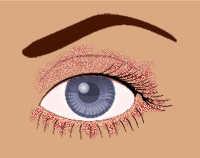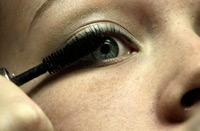Childrens Vision
Common Conditions
Contact Lens News
Miscellaneous
Nutrition and Eyes
Safety Eyewear
Sports
Blepharitis
Blepharitis is an inflammation of the eyelids causing red, irritated, itchy eyelids and the formation of dandruff-like scales on eyelashes. It is a common eye disorder caused by either bacterial or a skin condition such as dandruff of the scalp or acne rosacea. It affects people of all ages. Although uncomfortable, blepharitis is not contagious and generally does not cause any permanent damage to eyesight.
Blepharitis is classified into two types:
- Anterior blepharitis occurs at the outside front edge of the eyelid where the eyelashes are attached.
- Posterior blepharitis affects the inner edge of the eyelid that comes in contact with the eyeball.
Individuals with blepharitis may experience a gritty or burning sensation in their eyes, excessive tearing, itching, red and swollen eyelids, dry eyes, or crusting of the eyelids. For some people, blepharitis causes only minor irritation and itching. However, it can lead to more severe signs and symptoms such as blurring of vision, missing or misdirected eyelashes, and inflammation of other eye tissue, particularly the cornea.
In many cases, good eyelid hygiene and a regular cleaning routine can control blepharitis. This includes frequent scalp and face washing, using warm compresses to soak the eyelids, and doing eyelid scrubs. In cases where a bacterial infection is the cause, various antibiotics and other medications may be prescribed along with eyelid hygiene.
What causes blepharitis?
 Blepharitis can appear as greasy flakes or scales around the base of the eyelashes.
Blepharitis can appear as greasy flakes or scales around the base of the eyelashes.
Anterior blepharitis is commonly caused by bacteria (staphylococcal blepharits) or dandruff of the scalp and eyebrows (seborrheic blepharitis). It may also occur due to a combination of factors, or less commonly may be the result of allergies or an infestation of the eyelashes.
Posterior blepharitis can be caused by irregular oil production by the glands of the eyelids (meibomian blepharitis) which creates a favorable environment for bacterial growth. It can also develop as a result of other skin conditions such as acne rosacea and scalp dandruff.
How is blepharitis diagnosed?
Blepharitis can be diagnosed through a comprehensive eye examination. Testing, with special emphasis on evaluation of the eyelids and front surface of the eyeball, may include:
- Patient history to determine any symptoms the patient is experiencing and the presence of any general health problems that may be contributing to the eye problem.
- External examination of the eye, including lid structure, skin texture and eyelash appearance.
- Evaluation of the lid margins, base of the eyelashes and meibomian gland openings using bright light and magnification.
- Evaluation of the quantity and quality of tears for any abnormalities.
A differentiation among the various types of blepharitis can often be made based on the appearance of the eyelid margins:
- Staphyloccal blepharitis patients frequently exhibit mild sticking together of the lids, thickened lid margins, and missing and misdirected eyelashes.
- Seborrheic blepharitis appears as greasy flakes or scales around the base of eyelashes and a mild redness of the eyelids.
- Ulcerative blepharitis is characterized by matted, hard crusts around the eyelashes that when removed, leave small sores that ooze and bleed. There may also be a loss of eyelashes, distortion of the front edges of the eyelids and chronic tearing. In severe cases, the cornea, the transparent front covering of the eyeball, may also become inflamed.
- Meibomian blepharitis is evident by blockage of the oil glands in the eyelids, poor quality of tears, and redness of the lining of the eyelids.
Using the information obtained from testing, your optometrist can determine if you have blepharitis and advise you on treatment options.
How is blepharitis treated?
Treatment depends on the specific type of blepharitis. The key to treating most types of blepharitis is keeping the lids clean and free of crusts.
 Limiting or stopping the use of eye makeup when treating blepharitis is often recommended, as its use will make lid hygiene more difficult.
Limiting or stopping the use of eye makeup when treating blepharitis is often recommended, as its use will make lid hygiene more difficult.
- Warm compresses can be applied to loosen the crusts, followed by gentle scrubbing of the eyes with a mixture of water and baby shampoo or an over-the-counter lid cleansing product. In cases involving bacterial infection, an antibiotic may also be prescribed.
- If the glands in the eyelids are blocked, the eyelids may need to be massaged to clean out oil accumulated in the eyelid glands.
- Artificial tear solutions or lubricating ointments may be prescribed in some cases.
- Use of an anti-dandruff shampoo on the scalp can help.
- Limiting or stopping the use of eye makeup is often recommended, as its use will make lid hygiene more difficult.
- If you wear contact lenses, you may have to temporarily discontinue wearing them during treatment.
Some cases of blepharitis may require more complex treatment plans. Blepharitis seldom disappears completely. Even with successful treatment, relapses may occur.
Blepharitis seldom disappears completely. Even with successful treatment, relapses may occur.
Self-care
An important part of controlling blepharitis involves treatment at home.
Directions for a Warm Soak of the Eyelids:
- Wash your hands thoroughly.
- Moisten a clean washcloth with warm water.
- Close eyes and place washcloth on eyelids for about 5 minutes, reheating the washcloth as necessary.
- Repeat several times daily.
Directions for an Eyelid Scrub:
- Wash your hands thoroughly.
- Mix warm water and a small amount of non-irritating (baby) shampoo or use a commercially prepared lid scrub solution recommended by your optometrist.
- Using a clean cloth (a different one for each eye) rub the solution back and forth across the eyelashes and edge of the closed eyelid.
- Rinse with clear water.
- Repeat with the other eye.
(c)2006-2008 American Optometric Association. All Rights Reserved.